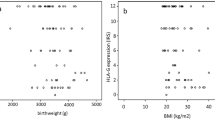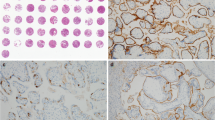Abstract
Lewis antigens belong to the blood group of antigens and mediate cellular adhesion through interaction with selectins. Invasive trophoblasts use an array of adhesion molecules to facilitate cell–cell and cell–extracellular matrix interactions. Here, we examined immunohistochemically the expression of Sialyl Lewis a (sLea), Sialyl Lewis x (sLex) and Lewis y (Ley) in term placentas obtained from cases of normal, intrauterine growth retardation (IUGR), preeclamptic (PE) and hemolysis, elevated liver enzymes and low platelets syndrome (HELLP) pregnancies. We report the expression of sLex in third trimester extravillous trophoblasts (EVT). sLex was significantly decreased in IUGR and moderately decreased in PE compared to normal placentas. sLex was additionally found in syncytiotrophoblast, without however any significant differences in staining intensity between normal and pathological cases. sLea was restricted to amnion epithelium. Finally, Ley was expressed in cytotrophoblasts and villous endothelial cells. Ley expression was significantly upregulated in IUGR and HELLP, whereas there was a trend toward increase in PE compared to normal placentas. The present study suggests that downregulation of sLex in EVT might be associated with IUGR and PE. Furthermore, Ley, which was recently described as a potent angiogenic factor, is upregulated in placental villi in conditions associated with placental malperfusion.






Similar content being viewed by others
References
Alpaugh ML, Tomlinson JS, Kasraeian S, Barsky SH (2002) Cooperative role of E-cadherin and sialyl-Lewis X/A-deficient MUC1 in the passive dissemination of tumor emboli in inflammatory breast carcinoma. Oncogene 21:3631–3643
Brosens IA, Robertson WB, Dixon HG (1972) The role of the spiral arteries in the pathogenesis of preeclampsia. Obstet Gynecol Annu 1:177–191
Burrows TD, King A, Loke YW (1994) Expression of adhesion molecules by endovascular trophoblast and decidual endothelial cells: implications for vascular invasion during implantation. Placenta 15:21–33
Chaddha V, Viero S, Huppertz B, Kingdom J (2004) Developmental biology of the placenta and the origins of placental insufficiency. Semin Fetal Neonatal Med 9:357–369
Hakomori S (1991) Possible functions of tumor-associated carbohydrate antigens. Curr Opin Immunol 3:646–653
Halloran MM, Carley WW, Polverini PJ, Haskell CJ, Phan S, Anderson BJ, Woods JM, Campbell PL, Volin MV, Backer AE, Koch AE (2000) Ley/H: an endothelial-selective, cytokine-inducible, angiogenic mediator. J Immunol 164:4868–4877
Jeschke U, Mylonas I, Shabani N, Kunert-Keil C, Schindlbeck C, Gerber B, Friese K (2005) Expression of sialyl Lewis X, sialyl Lewis A, E-cadherin and cathepsin-D in human breast cancer: immunohistochemical analysis in mammary carcinoma in situ, invasive carcinomas and their lymph node metastasis. Anticancer Res 25:1615–1622
King A, Loke YW (1988) Differential expression of blood-group-related carbohydrate antigens by trophoblast subpopulations. Placenta 9:513–521
Mylonas I, Speer R, Makovitzky J, Richter DU, Briese V, Jeschke U, Friese K (2000) Immunohistochemical analysis of steroid receptors and glycodelin A (PP14) in isolated glandular epithelial cells of normal human endometrium. Histochem Cell Biol 114:405–411
Mylonas I, Makovitzky J, Richter DU, Jeschke U, Briese V, Friese K (2003) Cathepsin D expression in normal, hyperplastic and malignant endometrial tissue: an immunohistochemical analysis. Acta Histochem 105:245–252
Ohyama C, Tsuboi S, Fukuda M (1999) Dual roles of sialyl Lewis X oligosaccharides in tumor metastasis and rejection by natural killer cells. Embo J 18:1516–1525
Pijnenborg R, Bland JM, Robertson WB, Brosens I (1983) Uteroplacental arterial changes related to interstitial trophoblast migration in early human pregnancy. Placenta 4:397–413
Prakobphol A, Genbacev O, Gormley M, Kapidzic M, Fisher SJ (2006) A role for the L-selectin adhesion system in mediating cytotrophoblast emigration from the placenta. Dev Biol 298:107–117
Reister F, Frank HG, Kingdom JC, Heyl W, Kaufmann P, Rath W, Huppertz B (2001) Macrophage-induced apoptosis limits endovascular trophoblast invasion in the uterine wall of preeclamptic women. Lab Invest 81:1143–1152
Remmele W, Hildebrand U, Hienz HA, Klein PJ, Vierbuchen M, Behnken LJ, Heicke B, Scheidt E (1986) Comparative histological, histochemical, immunohistochemical and biochemical studies on oestrogen receptors, lectin receptors, and Barr bodies in human breast cancer. Virchows Arch A Pathol Anat Histopathol 409:127–147
Stahn R, Goletz S, Wilmanowski R, Wang X, Briese V, Friese K, Jeschke U (2005) Human chorionic gonadotropin (hCG) as inhibitior of E-selectin-mediated cell adhesion. Anticancer Res 25:1811–1816
Takada A, Ohmori K, Yoneda T, Tsuyuoka K, Hasegawa A, Kiso M, Kannagi R (1993) Contribution of carbohydrate antigens sialyl Lewis A and sialyl Lewis X to adhesion of human cancer cells to vascular endothelium. Cancer Res 53:354–361
Walker JJ (2000) Pre-eclampsia. Lancet 356:1260–1265
Zhou Y, Fisher SJ, Janatpour M, Genbacev O, Dejana E, Wheelock M, Damsky CH (1997a) Human cytotrophoblasts adopt a vascular phenotype as they differentiate. A strategy for successful endovascular invasion? J Clin Invest 99:2139–2151
Zhou Y, Damsky CH, Fisher SJ (1997b) Preeclampsia is associated with failure of human cytotrophoblasts to mimic a vascular adhesion phenotype. One cause of defective endovascular invasion in this syndrome? J Clin Invest 99:2152–2164
Zhou Y, McMaster M, Woo K, Janatpour M, Perry J, Karpanen T, Alitalo K, Damsky C, Fisher SJ (2002) Vascular endothelial growth factor ligands and receptors that regulate human cytotrophoblast survival are dysregulated in severe preeclampsia and hemolysis, elevated liver enzymes, and low platelets syndrome. Am J Pathol 160:1405–1423
Zhou Y, Genbacev O, Fisher SJ (2003) The human placenta remodels the uterus by using a combination of molecules that govern vasculogenesis or leukocyte extravasation. Ann N Y Acad Sci 995:73–83
Acknowledgments
This work was supported by a project and grant from the German (DAAD) & Greek State Scholarships Foundation (IKYDA 2003)
Author information
Authors and Affiliations
Corresponding author
Additional information
U. Jeschke and A. Makrigiannakis have contributed equally.
Rights and permissions
About this article
Cite this article
Minas, V., Mylonas, I., Schiessl, B. et al. Expression of the blood-group-related antigens Sialyl Lewis a, Sialyl Lewis x and Lewis y in term placentas of normal, preeclampsia, IUGR- and HELLP-complicated pregnancies. Histochem Cell Biol 128, 55–63 (2007). https://doi.org/10.1007/s00418-007-0293-7
Accepted:
Published:
Issue Date:
DOI: https://doi.org/10.1007/s00418-007-0293-7




